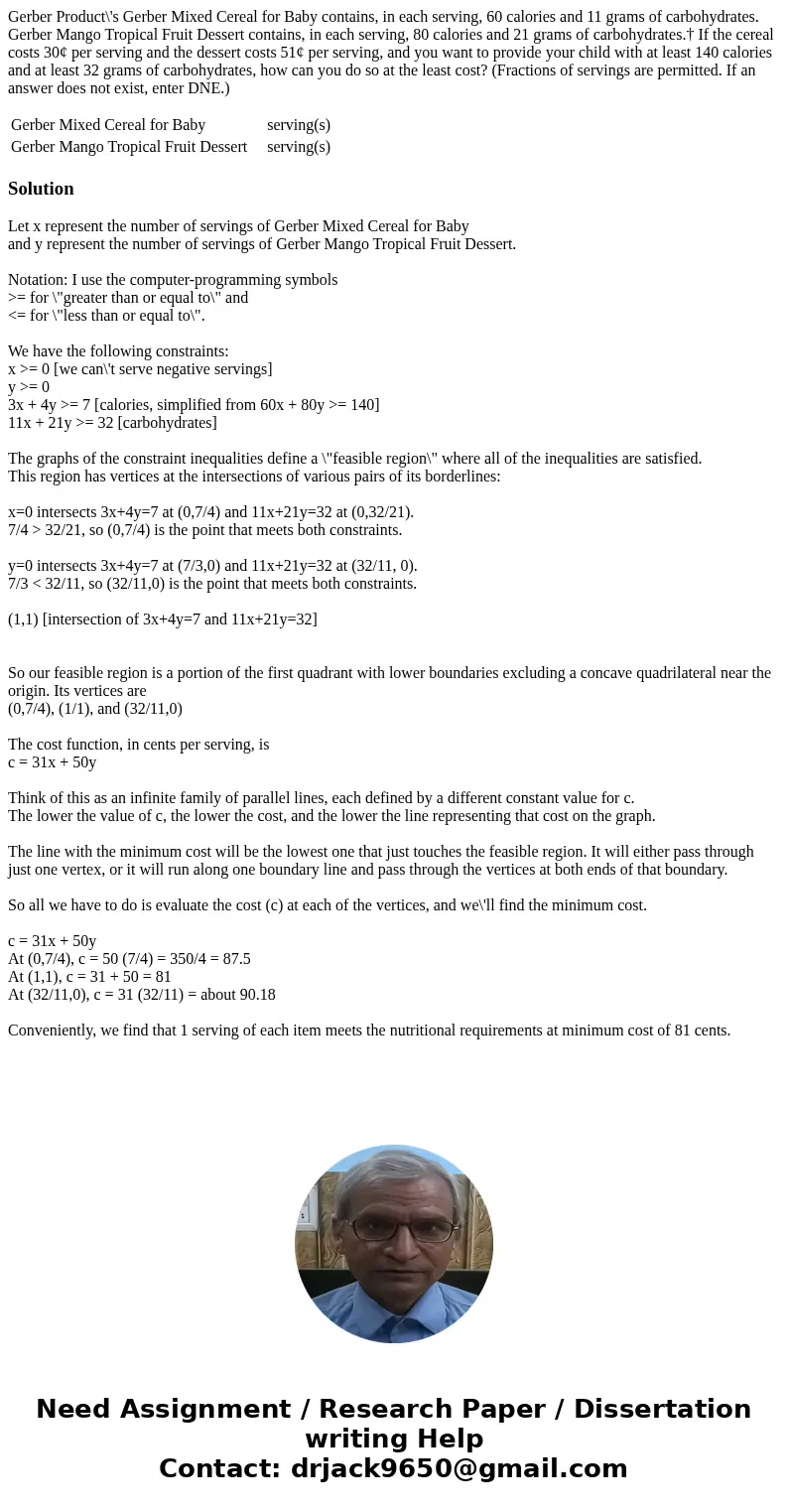Gerber Products Gerber Mixed Cereal for Baby contains in eac
Gerber Product\'s Gerber Mixed Cereal for Baby contains, in each serving, 60 calories and 11 grams of carbohydrates. Gerber Mango Tropical Fruit Dessert contains, in each serving, 80 calories and 21 grams of carbohydrates.† If the cereal costs 30¢ per serving and the dessert costs 51¢ per serving, and you want to provide your child with at least 140 calories and at least 32 grams of carbohydrates, how can you do so at the least cost? (Fractions of servings are permitted. If an answer does not exist, enter DNE.)
| Gerber Mixed Cereal for Baby | serving(s) |
| Gerber Mango Tropical Fruit Dessert | serving(s) |
Solution
Let x represent the number of servings of Gerber Mixed Cereal for Baby
and y represent the number of servings of Gerber Mango Tropical Fruit Dessert.
Notation: I use the computer-programming symbols
>= for \"greater than or equal to\" and
<= for \"less than or equal to\".
We have the following constraints:
x >= 0 [we can\'t serve negative servings]
y >= 0
3x + 4y >= 7 [calories, simplified from 60x + 80y >= 140]
11x + 21y >= 32 [carbohydrates]
The graphs of the constraint inequalities define a \"feasible region\" where all of the inequalities are satisfied.
This region has vertices at the intersections of various pairs of its borderlines:
x=0 intersects 3x+4y=7 at (0,7/4) and 11x+21y=32 at (0,32/21).
7/4 > 32/21, so (0,7/4) is the point that meets both constraints.
y=0 intersects 3x+4y=7 at (7/3,0) and 11x+21y=32 at (32/11, 0).
7/3 < 32/11, so (32/11,0) is the point that meets both constraints.
(1,1) [intersection of 3x+4y=7 and 11x+21y=32]
So our feasible region is a portion of the first quadrant with lower boundaries excluding a concave quadrilateral near the origin. Its vertices are
(0,7/4), (1/1), and (32/11,0)
The cost function, in cents per serving, is
c = 31x + 50y
Think of this as an infinite family of parallel lines, each defined by a different constant value for c.
The lower the value of c, the lower the cost, and the lower the line representing that cost on the graph.
The line with the minimum cost will be the lowest one that just touches the feasible region. It will either pass through just one vertex, or it will run along one boundary line and pass through the vertices at both ends of that boundary.
So all we have to do is evaluate the cost (c) at each of the vertices, and we\'ll find the minimum cost.
c = 31x + 50y
At (0,7/4), c = 50 (7/4) = 350/4 = 87.5
At (1,1), c = 31 + 50 = 81
At (32/11,0), c = 31 (32/11) = about 90.18
Conveniently, we find that 1 serving of each item meets the nutritional requirements at minimum cost of 81 cents.

 Homework Sourse
Homework Sourse